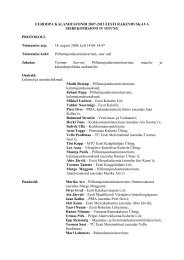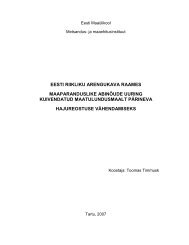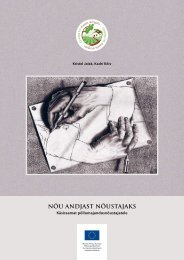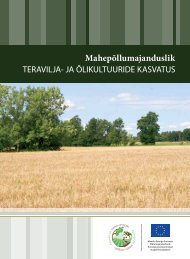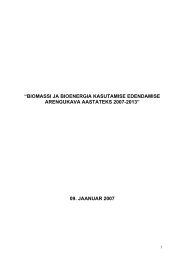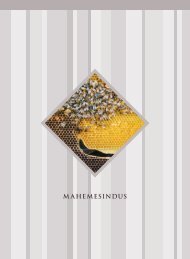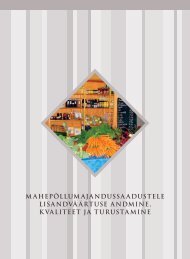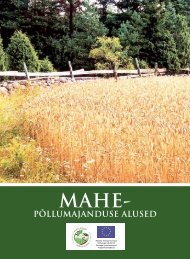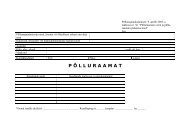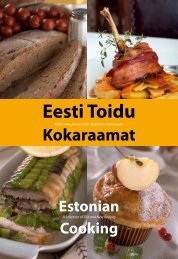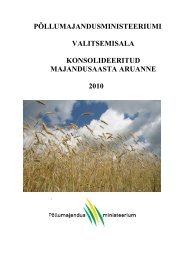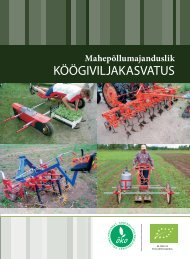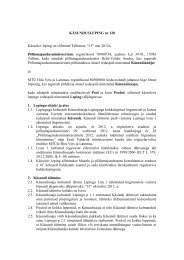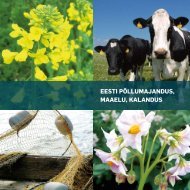estonian agriculture, rural economy and food industry
estonian agriculture, rural economy and food industry
estonian agriculture, rural economy and food industry
Create successful ePaper yourself
Turn your PDF publications into a flip-book with our unique Google optimized e-Paper software.
1.<br />
the Rakvere deposit, were discovered in the<br />
1970s. The estimated stock of the useful<br />
component (diphosphorus pentoxide) is ca<br />
700 million tonnes. To date, phosphorite<br />
has only been excavated from the Maardu<br />
deposit <strong>and</strong> is used for making single<br />
superphosphate <strong>and</strong> phosphorite powder.<br />
• Limestone <strong>and</strong> dolomite deposits are mainly<br />
located <strong>and</strong> on its isl<strong>and</strong>s <strong>and</strong> in the<br />
northern portions of Estonia. Limestone is<br />
used as raw material for cement, lime burning,<br />
construction stone <strong>and</strong> broken stone.<br />
Dolomite is mainly used as a decorative<br />
construction stone.<br />
• Mineral sea mud <strong>and</strong> organic-rich lake mud<br />
are used for therapeutic mud treatment.<br />
The main sea mud deposits are in the<br />
Haapsalu <strong>and</strong> Riga Bays.<br />
• Mineral water is obtained from boreholes<br />
in Värska near Lake Peipsi, <strong>and</strong> is sold as<br />
bottled drinking water under the br<strong>and</strong><br />
name Värska.<br />
• Next to Finl<strong>and</strong>, Estonia is one the richest<br />
countries in bogs; bogs occupy 24% of<br />
Estonia’s l<strong>and</strong> territory.<br />
• Bog areas are rich in peat: peat deposits<br />
cover 901,500 ha. The estimated peat stock<br />
is 2.37 billion tonnes. The annual maximum<br />
rate of peat use is 2.37 million tonnes<br />
as established by a Government resolution.<br />
Forty per cent of the extracted peat is<br />
exported; the remainder is used as horticultural<br />
fertiliser <strong>and</strong> as fuel for heating residential<br />
buildings.<br />
Soils<br />
• Soil quality is assessed on a point basis that<br />
is dependant on its fertility <strong>and</strong> technological<br />
conditions. The average soil rating of<br />
the total arable l<strong>and</strong> in Estonia is 41 points.<br />
• Soils above 50 points are regarded as good;<br />
Estonia’s coverage of this soil type is<br />
134,000 ha (12% of arable l<strong>and</strong>). Soils of<br />
average fertility (30–50 points) cover<br />
837,000 ha (74.6% of arable l<strong>and</strong>). Soils of<br />
low fertility (less than 30 points) cover<br />
151,000 ha (13.4% of arable l<strong>and</strong>).<br />
• The most fertile soils can be found in Järva,<br />
Jõgeva, Lääne-Viru, <strong>and</strong> Tartu counties.<br />
6



